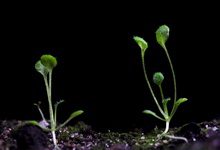
Dual Internal Clocks Keep Plant Defenses on Schedule
June 24, 2015| |
 A new study from Duke University shows that time management is not for busy people only -- it's for plants, too. The study shows how two biological clocks work together to help plants deal with intermittent demands such as infections, while maintaining an already-packed daily schedule of activities like growth.
A new study from Duke University shows that time management is not for busy people only -- it's for plants, too. The study shows how two biological clocks work together to help plants deal with intermittent demands such as infections, while maintaining an already-packed daily schedule of activities like growth.
Plant defense and other daily rhythms are thought to be driven by "morning genes" and "evening genes." Proteins made by the morning genes suppress the evening genes at the beginning of the day, but as the proteins start to build up within the cell they eventually turn themselves off. The subsequent drop in morning protein levels near the end of the day in turn activates the "evening" genes, creating a continuous 24-hour loop.
The researchers treated Arabidopsis plants with salicylic acid, to disrupt the normal daily fluctuation of reactive oxygen molecules in the plants' cells. They were surprised to find that the plants' circadian clock genes only made more proteins with the same regular rhythm. Using a mathematical model to explain the phenomenon, they found that rather than run fast or slow, plants treated with salicylic acid activated both their "morning" clock genes and their "evening" clock genes more strongly.
The researchers also identified a gene called NPR1 that links the two clocks, allowing them to work together. NPR1 senses changes in the "tick-tock" of the plants' reactive oxygen species clock, and responds by turning up both the "morning" and the "evening" genes in the other clock.
For more details, read the news release at DukeToday.
| |
Biotech Updates is a weekly newsletter of ISAAA, a not-for-profit organization. It is distributed for free to over 22,000 subscribers worldwide to inform them about the key developments in biosciences, especially in biotechnology. Your support will help us in our mission to feed the world with knowledge. You can help by donating as little as $10.
-
See more articles:
-
News from Around the World
- Scientific American Worldview 2015 Presents 100 Most Influential People in Biotech
- ACP and FAO Strengthen Ties to Achieve Sustainable Development Goals
- Genetic Study of 'Co-evolution' Could Provide Clues to Better Food Production
- U.S. FDA Approves GLA Safflower Meal for Feed Use
- Dual Internal Clocks Keep Plant Defenses on Schedule
- Gene Controlling Soybean's Seed Permeability and Calcium Content Identified
- Small Changes have Large Benefits for Crop Breeding
- Wild Tobacco Plant can be a Key in Attaining Food Security
- Van Montagu Receives Iran Agriculture Gold Medal
- GM Technologies Important Tools, Irish National Parliament Told
-
Research Highlights
- Metabolic Engineering of 2-Phenylethanol Pathway Produces Fragrance Chemical and Reduces Lignin Content in Arabidopsis
- Arabidopsis Leucine-Rich Repeat Extensin (LRX) Vital in Cell Wall Development
-
Beyond Crop Biotech
- Ancestry of Native Welsh Sheeps Revealed
- University of the Philippines Explores Faster Salmonella Detection in Meat through Biotech
-
Resources
- New Video: The Journey of Mr. Maize to the EU
-
Read the latest: - Biotech Updates (December 17, 2025)
- Gene Editing Supplement (December 17, 2025)
- Gene Drive Supplement (February 22, 2023)
-
Subscribe to BU: - Share
- Tweet
